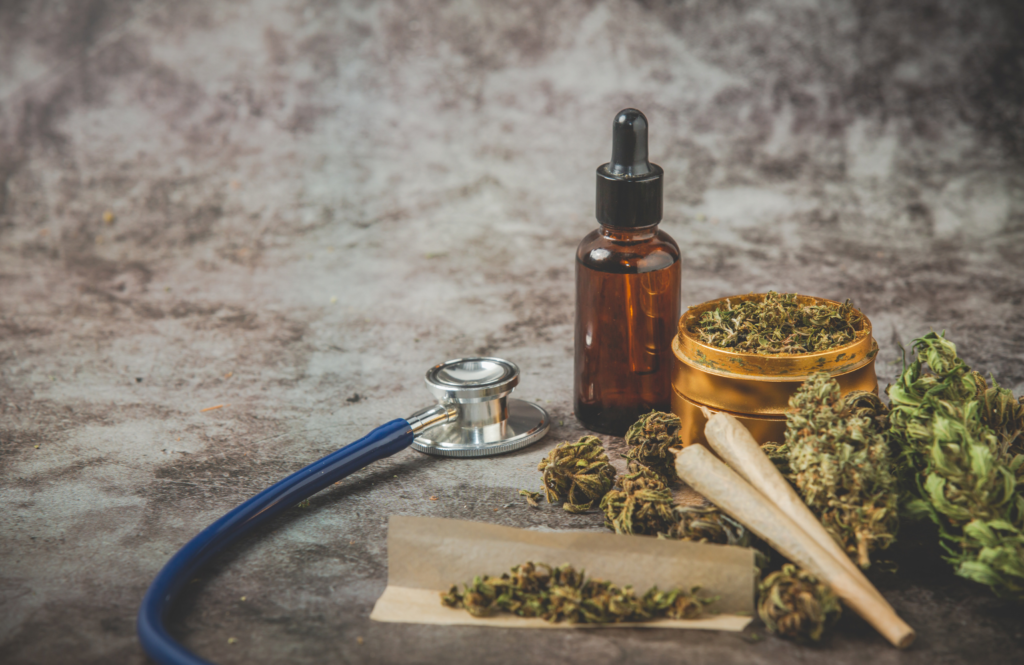For millions of Americans, chronic pain is a daily battle. Prescription painkillers—especially opioids—have long been the go-to treatment, but they come with high risks: addiction, overdose, and long-term dependency. Now, patients are finding another way.
According to a national survey, medical marijuana is emerging as a safer, more sustainable option for managing chronic pain. For many, cannabis doesn’t just reduce discomfort—it helps them cut back or even eliminate prescription drug use altogether.
This growing trend reflects a shift in both medicine and mindset. Where opioids numb pain at a cost, cannabis appears to restore balance without severe side effects. Patients describe better sleep, less anxiety, and improved mobility—benefits that go beyond symptom control.
Doctors and researchers are taking note. As new data accumulates, medical marijuana is no longer viewed as an alternative—it’s becoming a legitimate therapeutic tool in pain management.
The question now isn’t if cannabis works for chronic pain, but how far its benefits can reach.
The Green Health Docs Survey: What Patients Say
A new nationwide survey by Green Health Docs reveals how medical marijuana users view cannabis as a long-term solution for chronic pain. The poll included 1,450 patients from across the United States — and the results were striking.
Here’s what patients reported:
Overall Effectiveness
- 86% said cannabis improved their pain at least moderately.
- 56% reported significant pain reduction.
- Only about 1% said marijuana did not help with pain management.
Prescription Drug Reduction
- 48% used prescription painkillers before starting cannabis.
- After starting marijuana treatment:
- 35% stopped all prescription pain medications.
- 15% stopped using some.
- 12% reduced dosage or frequency.
Only - 18% reported no change.
- 35% stopped all prescription pain medications.
Daily Use and Long-Term Relief
- 73% said they use cannabis daily to manage pain.
- The majority believe it’s a viable long-term treatment, not a short-term fix.
Why They Chose Cannabis
- Lower risk of overdose compared to opioids.
- Fewer side effects and better symptom control.
- Multiple product options — oils, edibles, vapes, and topicals.
Quality of Life Improvements
- Patients reported better sleep, reduced anxiety, and increased mobility.
- Many said cannabis made day-to-day life more manageable and less dependent on prescriptions.
By the Numbers: Pain Relief and Prescription Reduction
The Green Health Docs survey breaks down just how much of an impact medical marijuana is having on chronic pain management — and the numbers speak for themselves.
Here’s the data at a glance:
Pain Improvement Rates
- 86% of patients experienced some level of relief.
- 56% said the reduction was significant, improving overall comfort and mobility.
Prescription Painkiller Reduction
- Before cannabis use, 48% relied on prescription pain medications.
- After adopting medical marijuana:
- 35% completely stopped using prescription pain meds.
- 15% discontinued some medications.
- 12% cut back on dosage or frequency.
- 35% completely stopped using prescription pain meds.
- Only 18% reported no change in prescription use.
Long-Term Treatment Patterns
- 73% of respondents use cannabis daily for pain relief.
- Over 98% believe it’s a viable long-term treatment option.
- Fewer than 2% disagree or report diminishing benefits over time.
Overall Satisfaction
- The majority of patients said cannabis offers consistent pain control without the side effects common in opioids.
- Many described the switch as “life-changing” or “the first real relief in years.”
Broader Trend
- The data aligns with multiple independent studies showing a steady decline in opioid prescriptions in states where medical marijuana is legal.
- Cannabis isn’t just an alternative — for many, it’s becoming the preferred first-line therapy for chronic pain.
Why Patients Prefer Cannabis Over Opioids
Patients are increasingly turning to medical marijuana as a safer, more manageable option for long-term pain relief. Unlike opioids, which often bring serious side effects and dependency risks, cannabis offers control, flexibility, and balance.
Here’s why patients are making the switch:
- Lower Risk of Overdose
- Opioids can slow breathing and cause fatal overdoses.
- Cannabis has no known lethal dose, making it far safer for long-term use.
- Opioids can slow breathing and cause fatal overdoses.
- Fewer Side Effects
- Opioids often cause nausea, constipation, fatigue, and dependency.
- Cannabis side effects are typically mild and short-term, such as dry mouth or temporary dizziness.
- Opioids often cause nausea, constipation, fatigue, and dependency.
- Greater Flexibility
- Cannabis can be taken in multiple forms — oils, edibles, tinctures, capsules, or flower.
- Patients can personalize dosage and consumption style to match their pain levels and lifestyle.
- Cannabis can be taken in multiple forms — oils, edibles, tinctures, capsules, or flower.
- Better Long-Term Tolerance
- Opioid tolerance builds quickly, forcing higher doses over time.
- Cannabis users rarely experience severe tolerance, keeping doses stable for months or years.
- Opioid tolerance builds quickly, forcing higher doses over time.
- Improved Mental and Emotional Balance
- Many patients report feeling calmer, less anxious, and more in control.
- Cannabis may help reduce stress-related pain amplification, which opioids often worsen.
- Empowerment in Treatment
- Cannabis gives patients a sense of agency over their pain care.
- They can adjust their regimen without depending heavily on prescription renewals or fear of withdrawal.
Scientific Support — Studies Backing the Findings
The Green Health Docs survey isn’t alone in its results. A growing body of research now supports the idea that medical marijuana can ease chronic pain and reduce prescription drug use, especially opioids.
Here’s what leading studies have found:

Pain Management (2025)t
- Found that co-prescription of cannabinoids helps patients reduce opioid use for chronic pain.
- Patients experienced sustained relief without higher tolerance or withdrawal.
Drug and Alcohol Review (2025)
- Showed that daily cannabis users with chronic pain were more likely to quit opioids completely.
- The effect was stronger among men and long-term users.
American Medical Association (AMA) Report (2023)
- Chronic pain patients using medical marijuana for longer than a month saw major drops in opioid prescriptions.
- About one in three chronic pain patients said cannabis replaced other pain drugs.
BMJ Open (2024)
- Compared cannabis and opioids for chronic non-cancer pain.
- Found that cannabis was similarly effective with fewer discontinuations due to side effects.
Medicaid Prescription Data Analysis (2022)
- States that legalized marijuana saw significant reductions in prescription drug use for pain and other conditions.
- Evidence points to cannabis as a cost-effective, lower-risk alternative for long-term treatment.
Additional Findings
- Studies link medical marijuana legalization to fewer opioid overdose deaths.
- Payments from opioid manufacturers to doctors dropped after cannabis laws took effect — suggesting shifts in medical practice.
Medical Marijuana vs. Opioids — A Safer Substitute
When it comes to chronic pain management, opioids have long been the standard — but they also come with high costs: dependence, tolerance, and overdose risk. Medical marijuana offers a different, safer path that’s gaining attention among doctors and patients alike.
Here’s how the two compare:
Mechanism of Action
- Opioids: Bind to opioid receptors in the brain and spinal cord to block pain signals, often suppressing breathing and mood regulation.
- Cannabis: Works with the endocannabinoid system to reduce inflammation, modulate pain perception, and support body balance.
Risk Profile
- Opioids: Highly addictive; can lead to tolerance, dependence, and overdose.
- Cannabis: Non-lethal, non-addictive for most users, and much lower risk of physical dependency.
Side Effects
- Opioids: Cause nausea, constipation, drowsiness, and depression.
- Cannabis: Side effects are mild and temporary — dry mouth, dizziness, or appetite changes.
Tolerance and Withdrawal
- Opioids: Users require higher doses over time and experience severe withdrawal when stopping.
- Cannabis: Tolerance develops slowly; withdrawal symptoms are minor and short-lived.
Effectiveness Over Time
- Opioids: Short-term relief often fades, leading to dose escalation.
- Cannabis: Provides consistent, long-term symptom control for many patients.
Public Health Impact
- Opioid: related overdose deaths have fallen in states with legal marijuana programs.
- Cannabis: access is linked to lower opioid prescriptions and reduced healthcare costs.
Therapeutic Flexibility
- Cannabis: can be adjusted by strain, ratio, and method (THC/CBD balance, edibles, oils, topicals).
- Opioids: offer little flexibility and require strict medical supervision.
Economic and Social Impacts of Legalization
Legalizing medical marijuana hasn’t just helped patients—it’s reshaping healthcare and public health economics. The ripple effects are now visible in prescription patterns, overdose rates, and even physician incentives.
Here’s how legalization is making an impact:
Reduced Opioid Prescriptions
- States with medical marijuana laws report a notable drop in opioid prescriptions.
- Patients are substituting cannabis for pain relief, lowering demand for high-risk drugs.
- This shift also helps reduce healthcare costs tied to addiction treatment and hospitalizations.
Fewer Overdose Deaths
- Research shows a consistent decline in opioid-related deaths in states that legalized marijuana.
- On average, these states report 3.5 fewer overdose deaths per 100,000 people.
- Earlier adopters of legalization see the strongest protective effect.
Lower Pharmaceutical Influence
- Legalization has led to decreased financial payments from opioid manufacturers to doctors.
- With cannabis available, physicians rely less on prescription painkillers, reducing industry pressure.
Public Health Benefits
- Legal access to cannabis has reduced rates of prescription drug misuse.
- Fewer people are turning to black-market opioids or unsafe substitutes.
- The trend suggests marijuana may function as a harm reduction tool in the opioid crisis.
Economic Growth
- The medical marijuana industry supports thousands of jobs and generates tax revenue that can fund health initiatives.
- States reinvest these funds in addiction recovery, education, and public safety programs.
Shifts in Public Perception
- As more people see tangible results, cannabis is gaining legitimacy as a therapeutic medicine rather than a taboo substance.
- Polls show rising confidence in marijuana’s safety compared to alcohol or prescription painkillers.

The Road Ahead — Integrating Cannabis into Pain Care
The evidence is clear: medical marijuana is no longer just an alternative — it’s becoming a core part of chronic pain treatment. But as more patients turn to cannabis, the next challenge lies in integrating it safely and effectively into mainstream healthcare.
Here’s what comes next:
- Medical Integration
- Doctors need standardized guidelines for dosage, product type, and frequency.
- Training programs are expanding to help physicians understand cannabis-based pain management.
- Doctors need standardized guidelines for dosage, product type, and frequency.
- Regulation and Quality Control
- Consistency in product purity, labeling, and potency is crucial.
- Stronger testing and oversight will ensure patients get safe, reliable medicine.
- Consistency in product purity, labeling, and potency is crucial.
- Insurance and Accessibility
- Most insurance plans don’t cover medical cannabis yet.
- Broader coverage could make it a cost-effective alternative to opioids for millions of patients.
- Most insurance plans don’t cover medical cannabis yet.
- Expanding Clinical Research
- Large-scale, long-term studies are needed to confirm how cannabis interacts with chronic pain, inflammation, and other medications.
- This data will help refine dosing, minimize side effects, and personalize treatment plans.
- Large-scale, long-term studies are needed to confirm how cannabis interacts with chronic pain, inflammation, and other medications.
- Balancing Risks and Rewards
- Cannabis is not risk-free — it can cause dependency or mental health issues in some users.
- The goal is to maximize therapeutic value while minimizing harm through education and monitoring.
- Cannabis is not risk-free — it can cause dependency or mental health issues in some users.
- Changing Medical Culture
- The stigma surrounding cannabis is fading, replaced by scientific curiosity.
- As doctors and policymakers see real-world results, cannabis is being recognized as a legitimate therapeutic tool, not a last resort.
- The stigma surrounding cannabis is fading, replaced by scientific curiosity.
The future of pain care will likely blend traditional medicine with cannabinoid therapy — offering patients options that are safer, more flexible, and more sustainable. What began as an alternative treatment is now shaping up to be a new standard in chronic pain management.



